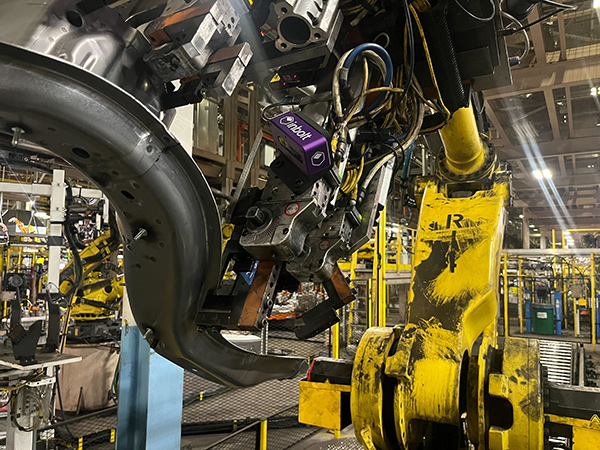How AI-powered 3D vision systems help robots adapt in real time, cutting downtime and tooling needs in modern factories.
By Albane Dersy
For years, manufacturers heard the same promise: robots that could “see” like humans. But the first wave of so-called computer vision was disappointing. Early 2D systems couldn’t handle depth, lighting, or perspective. A shiny surface could throw the whole process off. Change the light source, and suddenly you had misreads and rejected parts.
The irony? These costly systems actually made things more complicated in many cases. Engineers had to fight the limitations of the camera instead of letting the robot solve problems.
That’s why the move to 3D, especially when combined with AI, has been such a breakthrough. A 3D camera doesn’t just take a flat snapshot; it understands depth, angles, and spatial context. Pair that with machine learning, and you get a system that can make sense of what it sees and respond in real time. Not just precision, but adaptability.
And in a factory where change is constant, adaptability is worth its weight in gold.

Think back a decade. To install an industrial robot, you didn’t just buy the arm; you had to build the factory around it. Precision jigs, fixed tooling, endless reprogramming. If a part was off by a few millimeters, production stopped.
3D AI vision flips that model. Instead of forcing the factory to accommodate the robot, the robot accommodates the factory. Parts can come in misaligned, lighting can shift, tools can wear out, and the system continues to run.
Retraining is fast, too. No more weeks of coding. In many cases, an engineer can upload a CAD file, let the AI run a few cycles, and the robot is up and running in under an hour. That flexibility is what makes concepts like the “dark factory” less science fiction and more a reality within reach.
Imagine a fully automated plant where a rack shifts slightly out of place. Ten years ago, that would have caused a shutdown until someone showed up to fix it. With AI vision, the robot adjusts in real time. Production keeps moving. That ability to self-correct is what makes autonomy possible.
The impact of computer vision is no longer just a concept; it is a reality. It’s already transforming today’s production lines. For example, at Stellantis Valenciennes, a vision-guided system solved two major challenges: inconsistent part positioning and pallet deformation after heat treatment. Two Universal Robots equipped with real-time 3D vision now handle 2.7 tonnes of pieces with precision, eliminating the need for manual intervention and boosting efficiency.
In Detroit, Stellantis retrofitted a FANUC cell on the Body Side Outer Aperture line, where ageing racks caused frequent breakdowns. The vision system eliminated pick errors, reduced downtime by 97%, and achieved ROI in just three months without any mechanical rework.
Here’s a common myth: advanced robotic vision is prohibitively expensive. For a long time, that was true. Hardware was bulky. Software was proprietary. Only deep-pocketed manufacturers could even experiment.
But today? Costs have come down dramatically. Vision kits can retrofit existing robot cells from big-name suppliers like ABB or FANUC. Engineers no longer need to be specialists; they can train a robot with a few files and a short learning cycle.
The bigger story, though, is ROI. Vision-enabled robots can slash downtime and eliminate the need for endless custom fixtures. Instead of waiting years to justify the investment, many manufacturers see payback in months.
So while sticker shock once scared people off, the financial equation has flipped. The real risk is holding back and letting competitors move ahead.
Blind robots still exist, and they still drain money. A robot without vision is only as good as the fixture it’s bolted to. One misaligned part, one change in the line, and suddenly you’re paying in downtime and lost production.
This isn’t just a technical issue; it’s a business one. In an industry where margins are tight and global competition is fierce, those delays add up. Manufacturers who continue to rely on rigid, blind automation are betting against the future.
Recent years have been a brutal reminder: factories don’t operate in a vacuum. The pandemic exposed fragile supply chains. Geopolitical shocks rattled production schedules. Labor shortages continue to reshape what’s possible.
And yet customer expectations haven’t softened. If anything, demand for customization and quick turnarounds is growing. Product cycles are shrinking.
Traditional automation that is rigid and inflexible doesn’t keep up with that pace. But vision-guided robots can. They’re built for change. Switching product lines, adjusting to new part geometries, even adapting to new suppliers. It all happens faster when the robot isn’t locked into a single view of the world. This new level of flexibility is an essential key to survival.
The vision of “lights-out” factories, facilities that run entirely without people, still sounds futuristic. And maybe it’s still a way off. However, the building blocks are already in place.
Robots that see, learn, and adjust in real time are chipping away at the need for constant human oversight. They don’t just prevent shutdowns; they allow manufacturers to build more resilient systems. When the next disruption comes, and it will, the companies with adaptable automation will be able to pivot quickly. The ones with rigid setups will stall.
That’s the real competitive divide emerging right now. Vision isn’t just about efficiency gains. It’s about future-proofing entire operations.
So here’s the real question: if vision systems are no longer prohibitively expensive, deliver a faster ROI, and future-proof factories, can any manufacturer really afford not to use them?
The answer, bluntly, is no. The industry has crossed the line from “can it be done” to “why haven’t you done it yet?”
Robots with vision aren’t a nice-to-have; they’re a must-have. They’re table stakes for the next generation of manufacturing.

About the Author:
Albane Dersy is the Co-founder and COO of Inbolt, a pioneer of real-time robot guidance solutions. She was named one of the Top 10 Women in Robotics 2025.
In this episode, I sat down with Beejan Giga, Director | Partner and Caleb Emerson, Senior Results Manager at Carpedia International. We discussed the insights behind their recent Industry Today article, “Thinking Three Moves Ahead” and together we explored how manufacturers can plan more strategically, align with their suppliers, and build the operational discipline needed to support intentional, sustainable growth. It was a conversation packed with practical perspectives on navigating a fast-changing industry landscape.